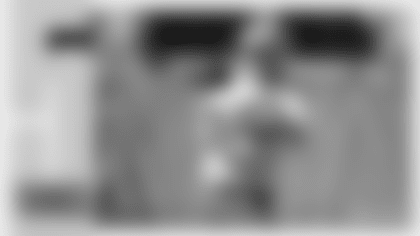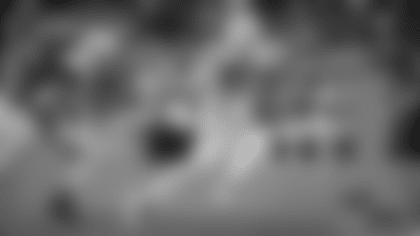Quarterback Aaron Rodgers said this week that Green Bay's offense is at its best when it can find a rhythm, but their struggles on first and second down have contributed to the Packers' inability to develop that during the first two games.
After ranking fifth in the league in 2008 in third-down conversions with a 44.2 percentage, the offense has seen a drop-off there through the first two weeks of this season, converting just 10-of-27 (37.0 percent) opportunities, which ranks tied for 20th in the NFL.
"I think we need to help (Aaron) more, and number one is winning more on first and second down and creating better third-down situations for him to be competitive in," Head Coach Mike McCarthy said. "Our biggest problem on offense is the down-and-distances we have been playing in generated by the negative plays we have had."
The Packers' 17 negative plays through two games, which doesn't include penalties, are the second most in the league, behind only Minnesota's 19. Besides the league-leading 10 sacks Green Bay has allowed, it also has had six negative rushing plays and one passing play that lost yardage.
That has played a large part in the Packers' need to pick up 10 yards or more 12 times on 27 third downs, second only to San Francisco's 16. In 2008 when the offense converted at a higher clip, Green Bay faced third-and-10 or more just 57 times all season.
"When you are putting yourselves in third-and-12s, third-and-16s, third-and-20s, guys know they can pin their ears back and come after you," guard Daryn Colledge said. "We have got to run the ball well, establish it, and put ourselves in some short down-and-distances and let A-Rod and these receivers do what they do best."
Of those 12 third-and-10-plus situations in the first two games, the Packers converted just one of them, a 22-yard pass from Rodgers to tight end Jermichael Finley on a third-and-10 on Green Bay's final possession against Cincinnati.
Of the Packers' 27 third-down plays, 16 of them (59.3 percent) have been third-and-8 or more, with just two conversions. Compare that to the 8-of-11 (72.7 percent) third downs they have converted when they are looking at third-and-7 or less, and the impact of the negative-yardage plays is obvious.
Getting into those improved third-down situations starts with production on first down, and that hasn't been there to this point either. Green Bay has gained just 213 yards on the opening down, second to last in the NFL, as the Packers rank last in the league in average yards to go on second down at 9.37.
That number has also been impacted by the sacks that the Packers have allowed, with six of the 10 coming on first down for a total yardage loss of 42 yards. It only makes sense that when they are facing long-yardage situations so often on second down, establishing the run becomes much more challenging.
"When we get into a rhythm we are tough to stop, and teams have been successful in kind of breaking that rhythm," Rodgers said. "Some of it has been the field-position battle because we started inside our 20 or what not. But we had a couple of drives there where we were inside the 35-yard line and then had a sack or a negative-yardage play, which took us out of field-goal range and then we took points off the board. We need to stay in third-and-manageable, and that in turn will give us a better opportunity to run the ball."
Because of the difficult down-and-distance situations, those opportunities just haven't been there as much in the running game, with only 40 rushing attempts through two games, second fewest in the league, compared to 67 passing attempts. The Packers also have only five runs of 10-plus yards, with three of those coming from Rodgers against Cincinnati, but he said the responsibility falls to the entire offense in the quest for more explosiveness.
{sportsad300}"The zone-blocking scheme is all about efficiency and hitting your aiming points every time and the fullback inserting the correct position and the running back making one cut and getting downhill," Rodgers said. "If we do all of those things correctly and I carry out the fake back-side and the receivers block, then that's when those 10, 12, 15, 40, 80-yard runs come. We haven't had those yet because it hasn't been all 11 of us on offense doing it the right way every time."
Injury/participation update
Cornerback/safety Jarrett Bush (ankle) was added to the injury report but was a full participant. McCarthy alluded to the fact that Bush had an ankle injury last season as well but didn't miss any games.
Running back Brandon Jackson (ankle), who was limited Wednesday in his first regular-season practice, suffered a setback and did not participate in Thursday's practice.
Tackle Chad Clifton (ankle) did not participate and won't play on Sunday. Safety Atari Bigby (knee) is out.
Kicker Mason Crosby (abdomen), who was limited on Wednesday, participated fully on Thursday.
Safety Nick Collins (chest) was limited for the second straight day, but McCarthy said he anticipates that Collins will be able to play on Sunday.
Fullback Korey Hall (shoulder/concussion) was limited and linebacker Aaron Kampman (hand) and nose tackle B.J. Raji (ankle) were full participants.
For the Rams, tackle Jason Smith (knee) did not participate for the second straight day. Center Jason Brown (knee), safety Craig Dahl (hamstring), guard John Greco (wrist) and safety David Roach (groin) were all full participants after being limited on Wednesday.














